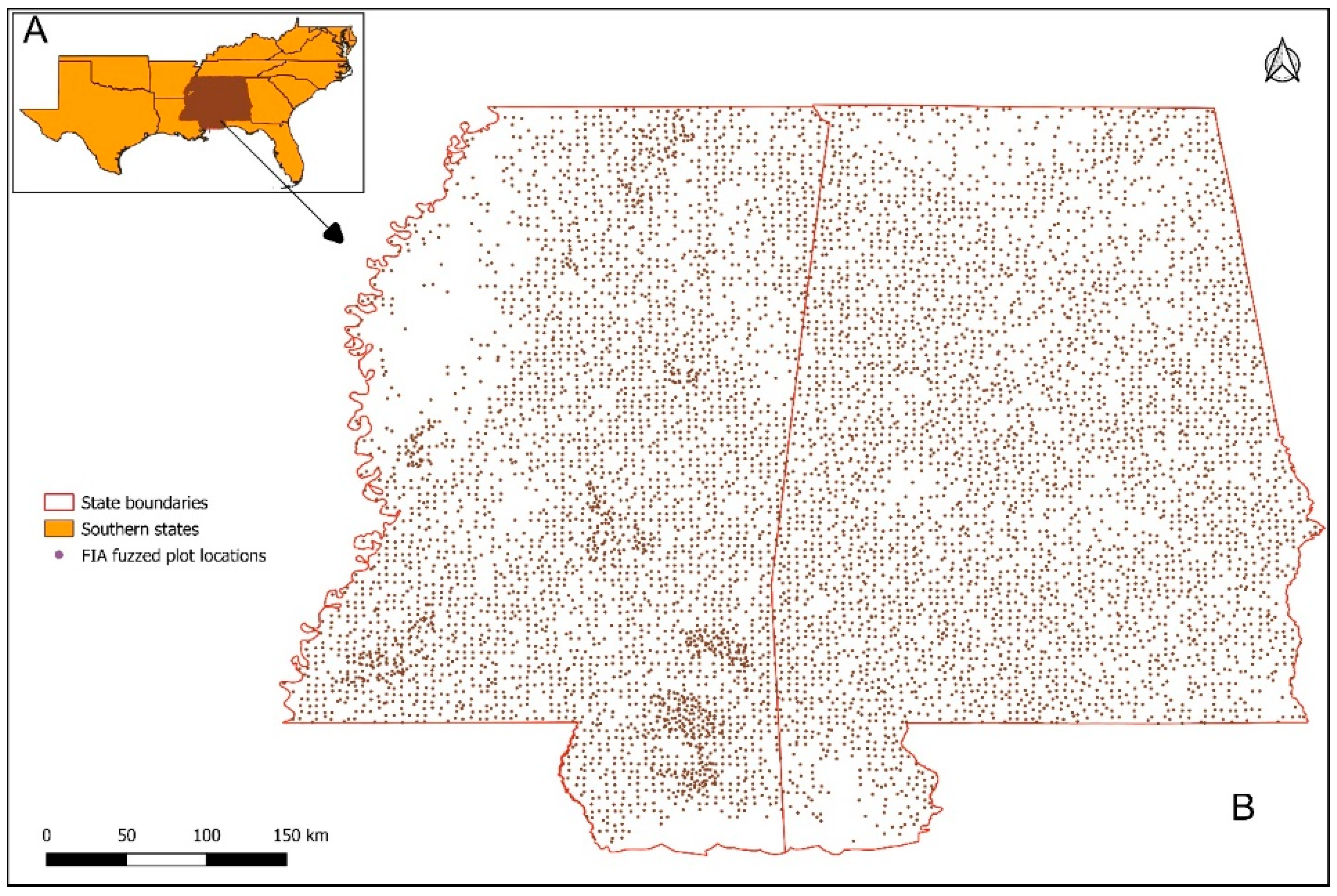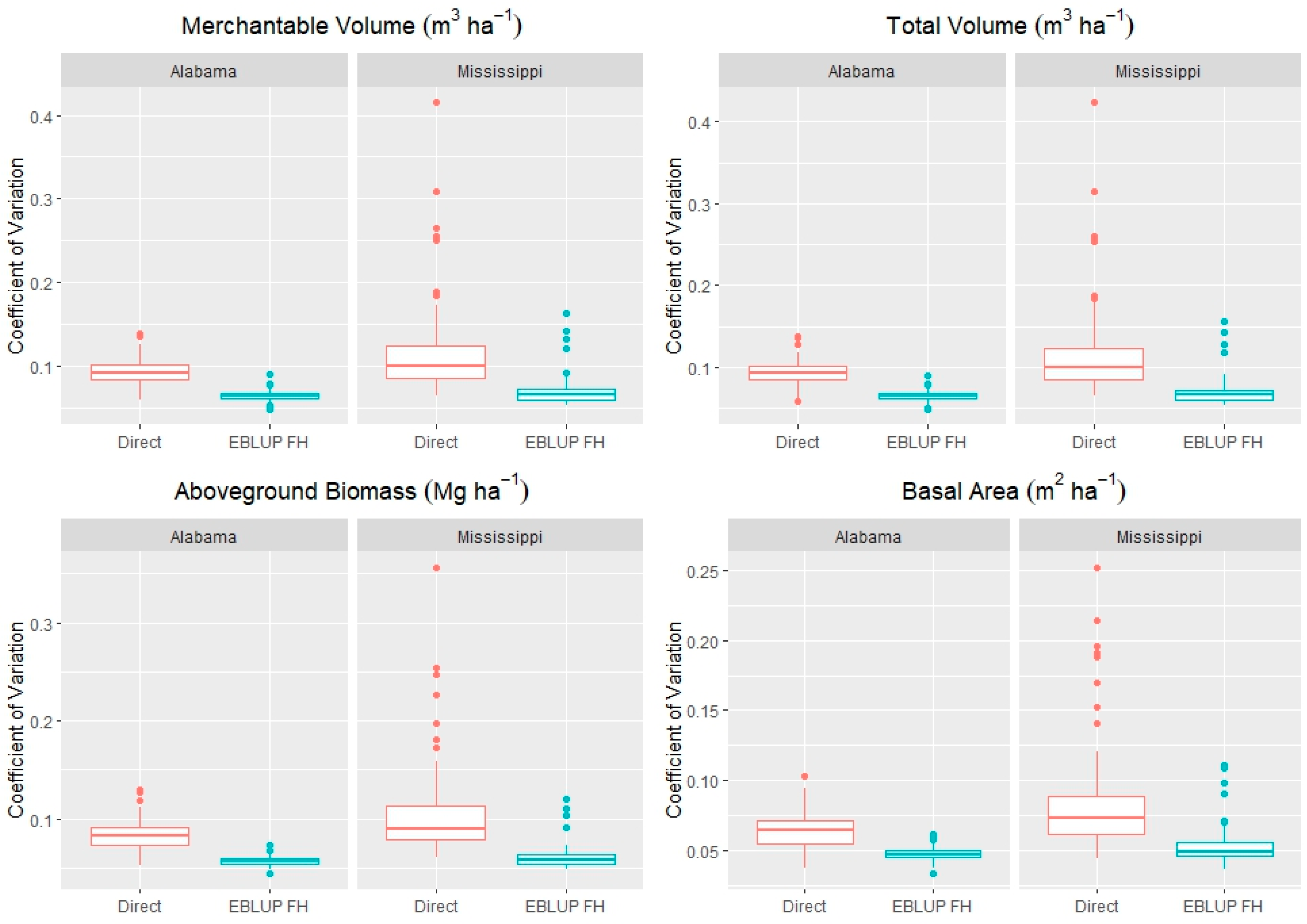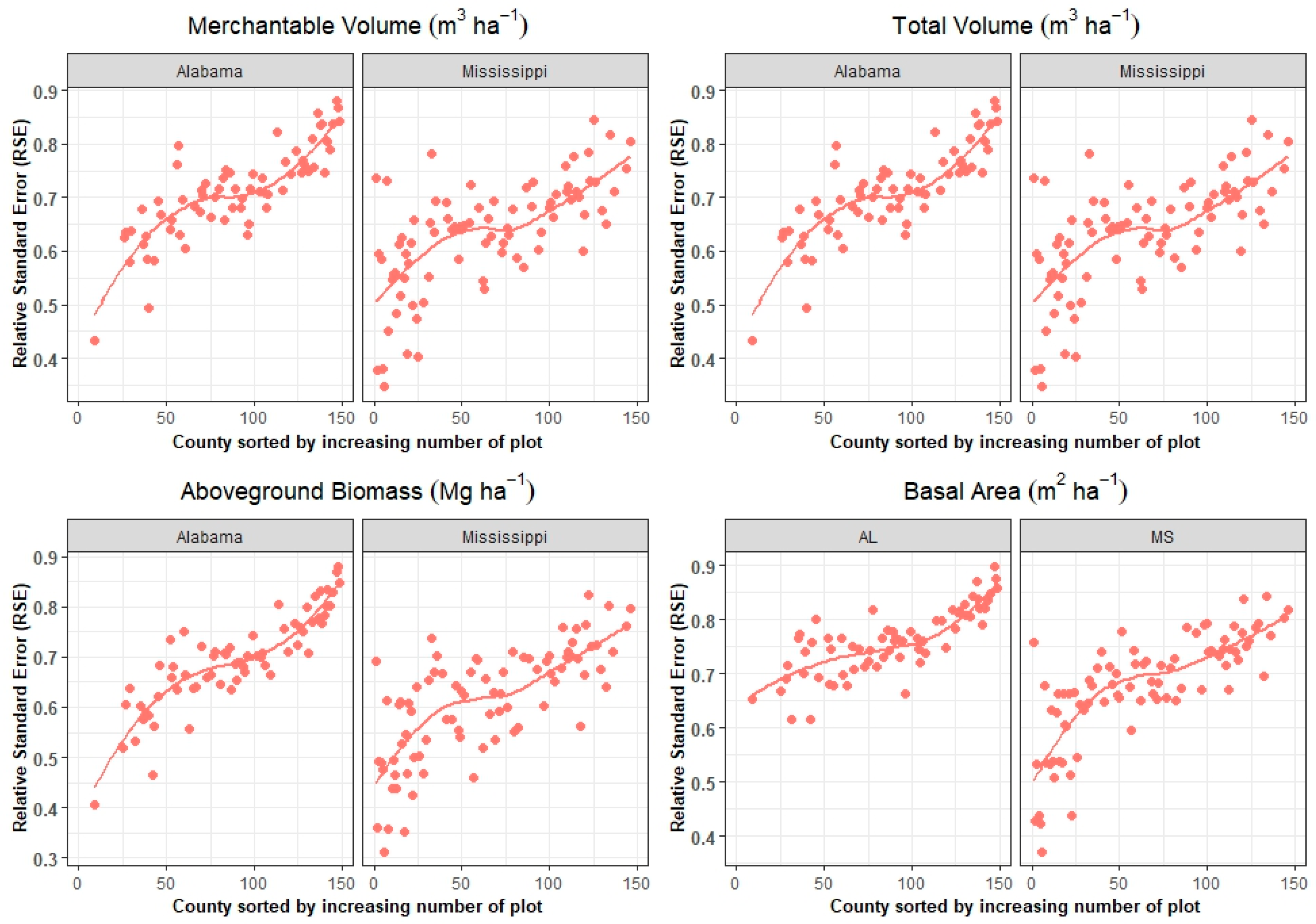Improving the Estimates of County-Level Forest Attributes Using GEDI and Landsat-Derived Auxiliary Information in Fay–Herriot Models
Abstract
1. Introduction
2. Materials and Methods
2.1. Study Area
2.2. Field Data
2.3. GEDI Data
2.4. Landsat Data
2.5. Direct Estimates
2.6. Indirect Estimation
2.7. Small Area Estimation
2.8. Model Evaluation
3. Results
3.1. Predictor Variables
3.2. Performance of the Composite Estimator
4. Discussion
5. Conclusions
Author Contributions
Funding
Data Availability Statement
Conflicts of Interest
Abbreviations
| AGB | Aboveground Biomass |
| BA | Basal Area |
| CHM | Canopy Height Metrics |
| CV | Coefficient of Variation |
| CVM | Merchantable Cubic Volume |
| CVT | Total Cubic Volume |
| DBH | Diameter at Breast Height |
| EBLUP | Empirical Best Linear Unbiased Predictor |
| FIA | Forest Inventory and Analysis |
| GEDI | Global Ecosystem Dynamics Investigation |
| GEE | Google Earth Engine |
| KICB2 | Kullback Information Criterion |
| NFI | National Forest Inventory |
| RMSE | Root Mean Square Error |
| RSE | Relative Standard Error |
| SAE | Small Area Estimation |
References
- Bechtold, W.A.; Patterson, P.L. (Eds.) The Enhanced Forest Inventory and Analysis Program—National Sampling Design and Estimation Procedures; Gen. Tech. Rep. SRS-80; U.S. Department of Agriculture, Forest Service, Southern Research Station: Asheville, NC, USA, 2005; Volume 080, p. 85. [Google Scholar] [CrossRef]
- Morin, R.S.; Pugh, S.A.; Liebhold, A.M.; Crocker, S.J. A regional assessment of emerald ash borer impacts in the Eastern United States: Ash mortality and abundance trends in time and space. In Proceedings of the Pushing Boundaries: New Directions in Inventory Techniques and Applications: Forest Inventory and Analysis (FIA) Symposium, Portland, OR, USA, 8–10 December 2015; pp. 233–236. [Google Scholar]
- May, P.; McConville, K.S.; Moisen, G.G.; Bruening, J.; Dubayah, R. A spatially varying model for small area estimates of biomass density across the contiguous United States. Remote Sens. Environ. 2023, 286, 113420. [Google Scholar] [CrossRef]
- Knott, J.A.; Liknes, G.C.; Giebink, C.L.; Oh, S.; Domke, G.M.; McRoberts, R.E.; Quirino, V.F.; Walters, B.F. Effects of outliers on remote sensing-assisted forest biomass estimation: A case study from the United States national forest inventory. Methods Ecol. Evol. 2023, 14, 1587–1602. [Google Scholar] [CrossRef]
- Goerndt, M.E.; Monleon, V.J.; Temesgen, H. A comparison of small-area estimation techniques to estimate selected stand attributes using LiDAR-derived auxiliary variables. Can. J. For. Res. 2011, 41, 1189–1201. [Google Scholar] [CrossRef]
- Goerndt, M.E.; Monleon, V.J.; Temesgen, H. Small-area estimation of county-level forest attributes using ground data and remote sensed auxiliary information. For. Sci. 2013, 59, 536–548. [Google Scholar] [CrossRef]
- Coulston, J.W.; Green, P.C.; Radtke, P.J.; Prisley, S.P.; Brooks, E.B.; A Thomas, V.; Wynne, R.H.; E Burkhart, H. Enhancing the precision of broad-scale forestland removals estimates with small area estimation techniques. Forestry 2021, 94, 427–441. [Google Scholar] [CrossRef]
- Cao, Q.; Dettmann, G.T.; Radtke, P.J.; Coulston, J.W.; Derwin, J.; Thomas, V.A.; Burkhart, H.E.; Wynne, R.H. Increased Precision in County-Level Volume Estimates in the United States National Forest Inventory With Area-Level Small Area Estimation. Front. For. Glob. Change 2022, 5, 769917. [Google Scholar] [CrossRef]
- Green, P.C.; Burkhart, H.E.; Coulston, J.W.; Radtke, P.J. A novel application of small area estimation in loblolly pine forest inventory. Forestry 2019, 93, 444–457. [Google Scholar] [CrossRef]
- Green, P.C.; Hogg, D.W.; Watson, B.; Burkhart, H.E. Small Area Estimation in Diverse Timber Types Using Multiple Sources of Auxiliary Data. J. For. 2022, 120, 646–659. [Google Scholar] [CrossRef]
- Dettmann, G.; Radtke, P.; Coulston, J.; Green, P.; Wilson, B.; Moisen, G. Review and Synthesis of Estimation Strategies to Meet Small Area Needs in Forest Inventory. Front. For. Glob. Change 2022, 5, 813569. [Google Scholar] [CrossRef]
- Mandallaz, D.; Breschan, J.; Hill, A. New regression estimators in forest inventories with two-phase sampling and partially exhaustive information: A design-based monte carlo approach with applications to small-area estimation. Can. J. For. Res. 2013, 43, 1023–1031. [Google Scholar] [CrossRef]
- Frescino, T.S.; McConville, K.S.; White, G.W.; Toney, J.C.; Moisen, G.G. Small Area Estimates for National Applications: A Database to Dashboard Strategy Using FIESTA. Front. For. Glob. Change 2022, 5, 779446. [Google Scholar] [CrossRef]
- Gomez-Rubio, V.; Best, N.; Richardson, S. A Comparison of Different Methods for Small Area Estimation; Working Paper; ESRC National Centre for Research Methods: Southampton, UK, 2009; Available online: https://eprints.ncrm.ac.uk/id/eprint/743/ (accessed on 1 September 2022).
- USDA Forest Service. Forests of Mississippi, 2020. 2022. Available online: https://www.fs.usda.gov/treesearch/pubs/64765 (accessed on 5 July 2025).
- Woudenberg, S.W.; Conkling, B.L.; O’connell, B.M.; Lapoint, E.B.; Turner, J.A. The Forest Inventory and Analysis Database: Database Description and Users Manual Version 4.0 for Phase 2; United States Department of Agriculture, Forest Service, Rocky Mountain Research Station: Fort Collins, CO, USA, 2010. [Google Scholar]
- Magnussen, S.; Mandallaz, D.; Breidenbach, J.; Lanz, A.; Ginzler, C. National forest inventories in the service of small area estimation of stem volume. Can. J. For. Res. 2014, 44, 1079–1090. [Google Scholar] [CrossRef]
- Hill, A.; Massey, A.; Mandallaz, D. The R Package forestinventory: Design-Based Global and Small Area Estimations for Multiphase Forest Inventories. J. Stat. Softw. 2021, 97, 1–40. [Google Scholar] [CrossRef]
- Rao, J.N.; Molina, I. Small Area Estimation; John Wiley & Sons: Hoboken, NJ, USA, 2015. [Google Scholar]
- Hidiroglou, M. Small-Area Estimation: Theory and Practice. In JSM Proceedings, Survery Research Methods Section; American Statistical Association: Alexandria, VA, USA, 2007. [Google Scholar]
- Costa, A.; Ventura, E.; Satorra, A. An Empirical Evaluation of Small Area Estimators. SORT (Stat. Oper. Res. Trans.) 2003, 27, 113–136. [Google Scholar] [CrossRef]
- McRoberts, R.E. Estimating forest attribute parameters for small areas using nearest neighbors techniques. For. Ecol. Manag. 2012, 272, 3–12. [Google Scholar] [CrossRef]
- Fay, R.E.; Herriot, R.A. Estimates of Income for Small Places: An Application of James-Stein Procedures to Census Data. J. Am. Stat. Assoc. 1979, 74, 269–277. [Google Scholar] [CrossRef]
- Battese, G.E.; Harter, R.M.; Fuller, W.A. An Error-Components Model for Prediction of County Crop Areas Using Survey and Satellite Data. J. Am. Stat. Assoc. 1988, 83, 28–36. [Google Scholar] [CrossRef]
- Brosofske, K.D.; Froese, R.E.; Falkowski, M.J.; Banskota, A. A Review of Methods for Mapping and Prediction of Inventory Attributes for Operational Forest Management. For. Sci. 2014, 60, 733–756. [Google Scholar] [CrossRef]
- Breidenbach, J.; Astrup, R. Small area estimation of forest attributes in the Norwegian National Forest Inventory. Eur. J. For. Res. 2012, 131, 1255–1267. [Google Scholar] [CrossRef]
- Goerndt, M.E.; Wilson, B.T.; Aguilar, F.X. Comparison of small area estimation methods applied to biopower feedstock supply in the Northern U.S. region. Biomass Bioenergy 2019, 121, 64–77. [Google Scholar] [CrossRef]
- McRoberts, R.E.; Næsset, E.; Gobakken, T. Inference for lidar-assisted estimation of forest growing stock volume. Remote Sens. Environ. 2013, 128, 268–275. [Google Scholar] [CrossRef]
- Gomillion, C.G.; Norrell, R.J. Alabama. In Encyclopedia Britannica; Encyclopedia Britannica, Inc.: Chicago, IL, USA, 2023. [Google Scholar]
- Alabama Forestry Commission. Alabama Forest Road Map 2020; Alabama Forestry Commission: Montgomery, AL, USA, 2020. Available online: https://forestry.alabama.gov/Pages/Management/Forms/Forest_Action_Plan.pdf (accessed on 5 July 2025).
- VanderSchaaf, C. Obtaining Biomass/Volume/Carbon Estimates Using EVALIDator Version 2.0.3 | Mississippi State University Extension Service. Available online: https://extension.msstate.edu/sites/default/files/publications/publications/P3830_web.pdf (accessed on 9 May 2023).
- Potapov, P.; Li, X.; Hernandez-Serna, A.; Tyukavina, A.; Hansen, M.C.; Kommareddy, A.; Pickens, A.; Turubanova, S.; Tang, H.; Silva, C.E.; et al. Mapping global forest canopy height through integration of GEDI and Landsat data. Remote Sens. Environ. 2021, 253, 112165. [Google Scholar] [CrossRef]
- Dubayah, R.; Luthcke, S.; Sabaka, T.; Nicholas, J.; Preaux, S.; Hofton, M. GEDI L3 Gridded Land Surface Metrics, version 1; ORNL DAAC: Oak Ridge, TN, USA, 2021. [Google Scholar] [CrossRef]
- Marhuenda, Y.; Morales, D.; del Carmen Pardo, M. Information criteria for Fay–Herriot model selection. Comput. Stat. Data Anal. 2014, 70, 268–280. [Google Scholar] [CrossRef]
- Kreutzmann, A.-K.; Pannier, S.; Rojas-Perilla, N.; Schmid, T.; Templ, M.; Tzavidis, N. The R Package emdi for Estimating and Mapping Regionally Disaggregated Indicators. J. Stat. Softw. 2019, 91, 1–33. [Google Scholar] [CrossRef]
- R Core Team. R: A Language and Environment for Statistical Computing; R Foundation for Statistical Computing: Vienna, Austria, 2023; Available online: https://www.R-project.org/ (accessed on 3 September 2023).
- Zhang, S.; Vega, C.; Deleuze, C.; Durrieu, S.; Barbillon, P.; Bouriaud, O.; Renaud, J.-P. Modelling forest volume with small area estimation of forest inventory using GEDI footprints as auxiliary information. Int. J. Appl. Earth Obs. Geoinform. 2022, 114, 103072. [Google Scholar] [CrossRef]
- Astola, H.; Häme, T.; Sirro, L.; Molinier, M.; Kilpi, J. Comparison of Sentinel-2 and Landsat 8 imagery for forest variable prediction in boreal region. Remote Sens. Environ. 2019, 223, 257–273. [Google Scholar] [CrossRef]
- Chrysafis, I.; Mallinis, G.; Siachalou, S.; Patias, P. Assessing the relationships between growing stock volume and Sentinel-2 imagery in a Mediterranean forest ecosystem. Remote Sens. Lett. 2017, 8, 508–517. [Google Scholar] [CrossRef]
- Antropov, O.; Rauste, Y.; Tegel, K.; Baral, Y.; Junttila, V.; Kauranne, T.; Hame, T.; Praks, J. Tropical forest tree height and above ground biomass mapping in Nepal using Tandem-X and ALOS PALSAR data. In Proceedings of the IGARSS 2018-2018 IEEE International Geoscience and Remote Sensing Symposium, Valencia, Spain, 22–27 July 2018; IEEE: New York, NY, USA, 2018; pp. 5334–5336. [Google Scholar]
- Asigbaase, M.; Dawoe, E.; Abugre, S.; Kyereh, B.; Nsor, C.A. Allometric relationships between stem diameter, height and crown area of associated trees of cocoa agroforests of Ghana. Sci. Rep. 2023, 13, 14897. [Google Scholar] [CrossRef]
- Temesgen, H.; Mauro, F.; Hudak, A.T.; Frank, B.; Monleon, V.; Fekety, P.; Palmer, M.; Bryant, T. Using Fay–Herriot Models and Variable Radius Plot Data to Develop a Stand-Level Inventory and Update a Prior Inventory in the Western Cascades, OR, United States. Front. For. Glob. Change 2021, 4, 745916. [Google Scholar] [CrossRef]
- Green, P.C.; Burkhart, H.E.; Coulston, J.W.; Radtke, P.J.; Thomas, V.A. Auxiliary information resolution effects on small area estimation in plantation forest inventory. Forestry 2020, 93, 685–693. [Google Scholar] [CrossRef]







| Variables | Alabama | Mississippi | Multi-State | |||
|---|---|---|---|---|---|---|
| Mean | Number of Plots | Mean | Number of Plots | Mean | Number of Plots | |
| AGB (Mg ha−1) | 124.09 | 4162 | 134.66 | 3879 | 129.90 | 8041 |
| CVT (m3 ha−1) | 146.1 | 4048 | 163.82 | 3797 | 155.83 | 7845 |
| CVM (m3 ha−1) | 144.4 | 4048 | 159.88 | 3797 | 152.93 | 7845 |
| BA (m2 ha−1) | 22.23 | 4162 | 23.67 | 3879 | 23.02 | 8041 |
| Predictor Variables | CVM (m3 ha−1) | CVT (m3 ha−1) | AGB (Mg ha−1) | BA (m2 ha−1) | ||||||||
|---|---|---|---|---|---|---|---|---|---|---|---|---|
| AL | MS | Multi-State | AL | MS | Multi-State | AL | MS | Multi-State | AL | MS | Multi-State | |
| Intercept | 80.0063 | 211.8518 | 248.9116 | 81.3008 | 207.7217 | 251.9239 | 140.0752 | 192.9993 | 2.1047 | 36.2126 | 37.2919 | |
| B2 | 7045.8547 | 7931.9659 | 5972.5224 | |||||||||
| B4 | 1.4518 | −8.4115 | −2.7365 | 1.4699 | −8.8589 | −2.6017 | −4.8016 | −2.1075 | 0.4080 | −0.5037 | −0.3459 | |
| B5 | −1.5650 | −1.0803 | −1.5540 | −1.0522 | −1.6079 | −0.9160 | 0.0698 | −0.1822 | −0.1406 | |||
| B6 | 2.8862 | 1.6100 | 2.9033 | 1.5436 | 0.1493 | 3.9110 | 1.3996 | 0.3027 | 0.1994 | |||
| B7 | −2854.0020 | −155.0650 | ||||||||||
| CHM5 | 0.0754 | |||||||||||
| CHM15 | −0.0361 | −0.0360 | −0.0411 | −0.0066 | ||||||||
| CHM20 | −0.0269 | −0.0324 | −0.0288 | −0.0348 | −0.0216 | −0.0032 | −0.0034 | |||||
| CHM25 | 0.0243 | 0.0549 | 0.0360 | 0.0233 | 0.0565 | 0.0360 | 0.0236 | 0.0274 | 0.0269 | 0.0041 | ||
| CHM35 | 0.3077 | 0.3290 | 0.2823 | 0.3082 | 0.3460 | 0.2926 | 0.3225 | 0.2789 | 0.2309 | 0.0427 | 0.0181 | |
| Variables of Interest | Direct Estimator | Composite Estimator | ||||
|---|---|---|---|---|---|---|
| Mean | CV | RMSE | Mean | CV | RMSE | |
| AGB (Mg ha−1) | 129.90 | 0.09 | 12.20 | 128.18 | 0.05 | 7.47 |
| CVT (m3 ha−1) | 155.83 | 0.10 | 16.15 | 153.20 | 0.06 | 10.31 |
| CVM (m3 ha−1) | 152.93 | 0.10 | 15.79 | 150.36 | 0.06 | 10.06 |
| BA (m2 ha−1) | 23.02 | 0.07 | 1.68 | 22.93 | 0.05 | 1.14 |
| Variables | Mississippi | Alabama | Multi-State |
|---|---|---|---|
| RSE | RSE | RSE | |
| AGB (Mg ha−1) | 0.57 (0.28–0.91) | 0.54 (0.30–0.97) | 0.64 (0.31–0.88) |
| CVT (m3 ha−1) | 0.57 (0.27–0.93) | 0.54 (0.30–0.97) | 0.67 (0.33–0.88) |
| CVM (m3 ha−1) | 0.57 (0.28–0.93) | 0.55 (0.32–0.97) | 0.66 (0.34–0.87) |
| BA (m2 ha−1) | 0.66 (0.35–0.90) | 0.54 (0.35–1.08) | 0.71 (0.36–0.90) |
Disclaimer/Publisher’s Note: The statements, opinions and data contained in all publications are solely those of the individual author(s) and contributor(s) and not of MDPI and/or the editor(s). MDPI and/or the editor(s) disclaim responsibility for any injury to people or property resulting from any ideas, methods, instructions or products referred to in the content. |
© 2025 by the authors. Licensee MDPI, Basel, Switzerland. This article is an open access article distributed under the terms and conditions of the Creative Commons Attribution (CC BY) license (https://creativecommons.org/licenses/by/4.0/).
Share and Cite
Alegbeleye, O.M.; Poudel, K.P.; VanderSchaaf, C.; Yang, Y. Improving the Estimates of County-Level Forest Attributes Using GEDI and Landsat-Derived Auxiliary Information in Fay–Herriot Models. Remote Sens. 2025, 17, 2407. https://doi.org/10.3390/rs17142407
Alegbeleye OM, Poudel KP, VanderSchaaf C, Yang Y. Improving the Estimates of County-Level Forest Attributes Using GEDI and Landsat-Derived Auxiliary Information in Fay–Herriot Models. Remote Sensing. 2025; 17(14):2407. https://doi.org/10.3390/rs17142407
Chicago/Turabian StyleAlegbeleye, Okikiola M., Krishna P. Poudel, Curtis VanderSchaaf, and Yun Yang. 2025. "Improving the Estimates of County-Level Forest Attributes Using GEDI and Landsat-Derived Auxiliary Information in Fay–Herriot Models" Remote Sensing 17, no. 14: 2407. https://doi.org/10.3390/rs17142407
APA StyleAlegbeleye, O. M., Poudel, K. P., VanderSchaaf, C., & Yang, Y. (2025). Improving the Estimates of County-Level Forest Attributes Using GEDI and Landsat-Derived Auxiliary Information in Fay–Herriot Models. Remote Sensing, 17(14), 2407. https://doi.org/10.3390/rs17142407









